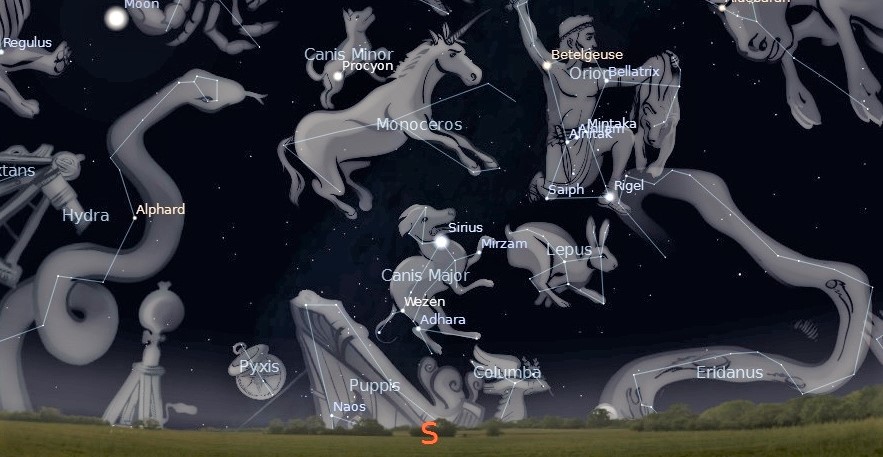This Week’s Sky at a Glance, 2021 February 27 – March 6
~by Curt Nason
Two of the largest constellations are seen in the southwest and southeast around mid-evening. Eridanus the River flows from Rigel in Orion’s foot to the lower right, and then makes a sharp curve to the left before disappearing below the horizon. It doesn’t end there; it extends at least the same distance southward to terminate at Achernar, the ninth brightest star in the sky. Achernar, of course, means “the river’s end.” The star near Rigel is named Cursa, which means “the footstool.” In terms of square degrees of sky, Eridanus is the sixth largest constellation. It has been associated with many earthly rivers but most often with the Po River in Italy, which the Greeks called Eridanos.
Hydra the female Water Snake rises out of the southeast, with its head reaching as high as Orion’s. A smaller constellation called Hydrus the male Water Snake is near Achernar and is never seen from New Brunswick. Hydra is the largest of the 88 constellations and one of the longest. If you consider the horizon as the ocean surface, and if you have all night, you can picture Hydra leaping completely out of the water and disappearing in a giant belly flop. Its brightest star, Alphard the “solitary one,” just makes the top 50 in terms of brightness. In mythology the Hydra was a multi-headed creature slain by Hercules as his second labour.
This Week in the Solar System
Saturday’s sunrise in Moncton is at 7:01 am and sunset will occur at 6:03 pm, giving 11 hours, 2 minutes of daylight (7:05 am and 6:09 pm in Saint John). Next Saturday the Sun will rise at 6:48 am and set at 6:12 pm, giving 11 hours, 24 minutes of daylight (6:52 am and 6:18 pm in Saint John).
The Moon is full this Saturday, the Snow Moon or Mi’kmaw Snow Blinding Moon, and it is at third quarter next Friday. Mars makes a scenic, colour-contrasting binocular view with the Pleaides all this week, making its closest pass on Thursday. Mercury is in close conjunction with Jupiter on Friday morning, one day before its greatest elongation from the Sun. Both rise an hour before sunrise, and Saturn sits about seven degrees to their upper right. For the first two weeks of March we have the opportunity to view the subtle wedge of zodiacal light in the west about 45 minutes after sunset, tapering up toward Mars and the Pleiades. A clear sky free of light pollution is required to view this phenomenon of sunlight reflecting off asteroid and comet dust along the ecliptic.
With astronomy meetings and outreach activities on hold, you can watch the local Sunday Night Astronomy Show at 8 pm and view archived shows.
Questions? Contact Curt Nason.

